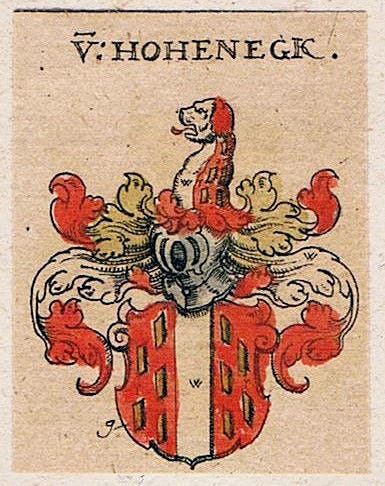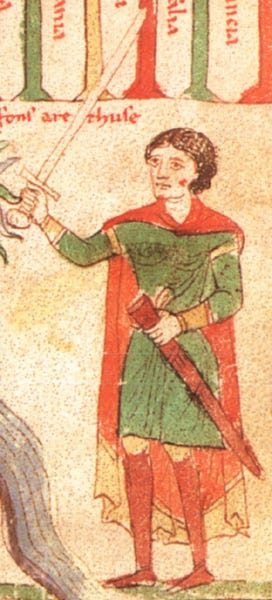A Society of only Nobles and Peasants?
It is often assumed that medieval society consisted only of the nobility and the peasantry. However, about 30% of the German Kingdom was composed of a third group—the ministeriales.
During the medieval Holy Roman Empire (HRE), a major group existed as the social tether between the nobles and peasants, known as the ministeriales. They began as palatial and estate administrators in the 9th century, but by the end of the 12th century, they had become political and martial advisors as well. However, their murky familial origins and lack of a comparative status in areas outside of the HRE during the Middle Ages, makes the ministeriales a unique feature of the time period and, consequently, often overlooked.
Where do they come from?
The first ministeriales of the 9th and early 10th centuries belonged to the status of the lower nobility, following in the Merovingian and Carolingian tradition of drawing palatial advisors from the families of the duces, comes, and grafio. A shift occurred in the beginning in the late 10th and first half of the 11th centuries, in which they were instead drawn from the servants of the familiae (elite families) of powerful kings, bishops, and other influential princes rather than the nobles themselves.[1]
In contrast to the nobles, who are determined as such based upon their ability to trace their ancestry and confirm ownership of an estate,[2] most of the ministeriales from the late 10th to the mid-13th centuries often lacked either of these defining qualities.
However, a series of legal reforms laid the foundation for their elevation in the 11th century, establishing the status of a ministerialis as independent of the familiae with the privilege of passing an inheritance.[3]
Despite its strong association with the High Middle Ages, the title of ministerialis owes its existence to Julius Caesar, according to the 12th century Chronicon Ebersheimense, which described the reform of the social structure instituted by Caesar during his conquest of Germania, noting that:
‘In contrast to other peoples, the knights of Germania were named fiscales regni and ministeriales principium’.[4]
What does the title mean?
The term ministerialis (plural: ministeriales), is derived from the Latin word minister, meaning attendant or servant. During the post-classical period of Latin, the word ministeriālis developed with regard to the ministerium, or ministry, of the Roman Emperors.
However, it is necessary to elaborate upon the finer details of the evolution of the term ministerialis, given its translation into Middle-High German during the 13th century as dienestman, and the semantics of the descendent word Dienstmann in High German. The Middle-High German word dienestman or dienestliute[5] can be broken down into the terms dienest, meaning service, and man, meaning man (liute meant people).
Both words exist in modern High German as dienst and Mann, though the modern connotation towards the term dienst is more in-line with the indentured/servile notion that was essentially abandoned by the late 12th century when referencing a ministerialis. Therefore, in the context of dienestman referencing a ministerialis in the 13th century, the Middle-High German word dienest most likely did not have the strictly servile connotation that it does in modern High German.
This subtle semantic shift has had a ripple effect through the literature surrounding the study of the ministeriales, in which the linguistics have been often overlooked. The problem is amplified when the terms are translated into another language in absence of the historical context. If careful consideration is not taken with regard to historical linguistics, the nuances of the term ministerialis from the 11th to 13th centuries can be missed altogether.
Why are they ignored?
Provided the linguistic complications of the German translation, the ministeriales have largely been ignored in medieval studies as they were assumed to have simply been indentured servants. Furthermore, the ministeriales did not have permanent surnames. Instead, they adopted surnames relating to the place of their commission, but changed the surname when recommissioned to another place.
For example, a certain Eckbert was born to a ministerialis of the Bishop of Worms, named Brunicho von Worms. This Brunicho was later commissioned at the court of the Count Palatine of the Rhine in Bacharach, at which point his name changed to Brunicho von Bacharach. Around the same time, his son, Eckbert was commissioned at the Count Palatine’s court in Alzey, upon which his name changed to Eckbert von Alzey. Soon thereafter, he was commissioned at the emperor’s court in Lautern, and—you guessed it—his name changed to Eckbert von Lautern!

The only way to find them is to look at the lists of names at the end of medieval charters where all witnesses of the recorded events are found, as ministeriales were not always active participants. However, they are not always included with their surname, requiring researchers to read dozens of charters before and after the one in question in order to assemble context.
To add one more element to the confusion, the word ‘von’ (meaning ‘of’ or ‘from’) does not necessarily denote nobility—as is commonly thought—but rather that someone is originally from a certain place. In turn, some ministeriales have been conflated as having been low status nobles.
Unless one traces all of the stations a particular person (or family), it is nearly impossible to assemble genealogies of the ministeriales. Furthermore, not all of their commissions are explicitly stated in the royal, imperial, or diocesan charters. Instead, much of their lives are hidden away in the registers of abbeys or counts, most of which are still in Latin and un-digitized—if a register was ever even assembled.
This makes it, at times, extraordinarily difficult to trace the movements of specific individuals—even more so considering that many of them had the same first name and served a commission in the same place at the same time (e.g. Siegfried von Lautern and his nephew, Siegfried von Lautern) It is for this reason, that most researchers of the Middle Ages have indeed acknowledged their existence but rarely delved into their stories.
Types of Ministeriales
They were highly stratified among three levels in which they performed different tasks:
The imperial ministeriales: those serving the emperors directly as administrators of the large palaces and estates, or in the personal entourages as chamberlains, cupbearers, marshals, and even as stewards.
The royal/bishopric ministeriales: those serving in the estates of the kings or bishops as sheriffs and foresters, or in their personal entourages as chamberlains, cupbearers, and marshals.
The county/monastic ministeriales: those serving local counts and monasteries as grounds keepers, minor sheriffs, foresters, and property managers.
They essentially served as the main administrators of the counts, monasteries, cathedrals, royal and imperial palaces, as well as the associated estates. Their interactions with one another formed political alliances and marriages that resulted in the elevation of ministeriales of a lower level to a higher one.
This formed a massive network of ministeriales across the three levels what can be described as the medieval administration of the HRE. It was the action of the ministeriales that put the policies of the nobles into effect. Interestingly, they followed the same marriage strategy as the nobles in which a son would marry the daughter of a higher status. In turn, the son of an imperial ministeriales could sometimes even marry the daughter of a count!
This provided the nobles of the HRE with a nearly endless source of new bloodlines, contrary to popular belief that they were all inbred tyrants.

The ministeriales serving the Hohenstaufen dynasty (ca. 1152 – 1250 AD) were even given noble titles. For example, Markward von Annweiler—a ministerialis who served under the emperors Frederick I and Henry VI—was named Margrave of Ancona, Duke of Romagna and Ravenna, and Count of Abruzzo and Molise, in addition to his administrator position as imperial steward by the year 1198.[6]
Markward’s accumulation of titles was a result of his services rendered to the Roman-German Kings and Emperors. Had he been a noble, his titles would have been passed on to his son—or at least the son would have had a right to a claim. Though upon his death, all of his positions were declared vacant, as he had only been a ministerialis. Although he had been given noble titles, he had not been formally ennobled underlining the fact that the ministeriales composed a social group a distinct from the nobles.
Nevertheless, many of the noble German families in later centuries owe their status to ministerialis forefathers, such as the families von Bolanden, von Hoheneck, or von Pappenheim—to name a few—who rose into the nobility towards the end of the 13th century. By the turn of the 14th century, the status of ministeriales had been largely abandoned as many of the families had become lower nobles.
These lower nobles were free-lords (Freiherren) and knights who had received small feudal territories within the realms of the estates their forefathers had served. This coincided with the rise of the citizens, or Bürger, who now ruled free cities within their illustrious city halls—many of whom were also descendants of the ministeriales.
Summary
The characteristics of the ministeriales as administrators, the ambiguity regarding their general status, and their capacity to hold titles roughly equivalent to those typically designated for the nobles, speaks to their extraordinary role within the society and politics of the High Middle Ages in the HRE. The fact that they have been ignored—especially within English and French literature—clearly indicates a massive area of un-researched medieval history ripe for the taking.
[1] Bosl, „Die Adelige Unfreiheit“. P. 12.
[2] Hechberger, Adel, Ministerialität und Rittertum im Mittelalter. P. 3.
[3] Ebd. P. 28.
[4] Keupp, Dienst und Verdienst: Die Ministerialen Friedrich Barbarossas und Heinrichs VI. P. 31. This is an excerpt from the Chronicon Ebersheimense. The original Latin text is as follows: Deinde cum Roman redire disponeret, conventum in Germania celebravit omnibusque valedicens, minors milites principbus commendavit, ut non quasi servis as famulis uterentur, sed quasi domini as defensores ministerial ipsorum reciperent. Inde accidit, quod preter nations ceteras Germani milites fiscales regni et ministeriales principum nuncupantur. The last sentence was translated by Keupp into German, and then by Pattee into English for this text. Keupp mentions that the chronicle seems to convey a positive notion towards the ministeriales by relating them back to Caesar.
[5] Ebd. P. 37. Keupp offers two versions of the same term derived from the Middle High German Dictionary.
[6] P. Prinz, Markward von Anweiler; Truchsess des Reiches, Markgraf von Ancona, Herzog der Romagna und von Ravenna, Graf von Abruzzo und Molise, 1. Aufl. (Emden: Druck von Theodor Hahn Wittwe, 1875).
Be sure to check these sources for more reading!
Bosl, Karl. „Die Adelige Unfreiheit“. In Ministerialität im Pfälzer Raum: Referate und Aussprachen der Arbeitstagung vom 12. bis 14. Oktober 1972 in Kaiserslautern, herausgegeben von Friedrich Ludwig Wagner, 1. Aufl., 64:9–23. Veröffentlichung der Verlag der Pfälzischen Geselleschaft zur Förderung der Wissenschaften. Speyer: Verlag der Pfälzischen Geselleschaft zur Förderung der Wissenschaften, 1975.
Hechberger, Werner. Adel, Ministerialität und Rittertum im Mittelalter. Herausgegeben von Lothar Gall. 2. Aufl. Bd. 72. München, Germany: R. Oldenbourg Verlag, 2010.
Keupp, Jan Ulrich. Dienst und Verdienst: Die Ministerialen Friedrich Barbarossas und Heinrichs VI. 1. Aufl. Monographien zur Geschichte des Mittelalters 48. Stuttgart: Anton Hiersemann, 2002.
Möller, Lenelotte, und Hans Ammerich. Die Salier. Wiesbaden: Marixverlag, 2015.
Prinz, P. Markward von Anweiler; Truchsess des Reiches, Markgraf von Ancona, Herzog der Romagna und von Ravenna, Graf von Abruzzo und Molise. 1. Aufl. Emden: Druck von Theodor Hahn Wittwe, 1875.
Repertorium „Geschichtsquellen des deutschen Mittelalters“. „Chronicon Ebersheimense“, 1. Juli 2019. https://www.geschichtsquellen.de/repOpus_01047.html.





You used the term "third group" rather than "middle class," and "class" is generally an imprecise and anachronistic term when used to describe medieval social structures, but nevertheless, for the sake of discussion—do you see any value in thinking of the ministeriales as fulfilling a role in the High Middle Ages comparable to that of the burgher/merchant class in the Late Middle Ages?